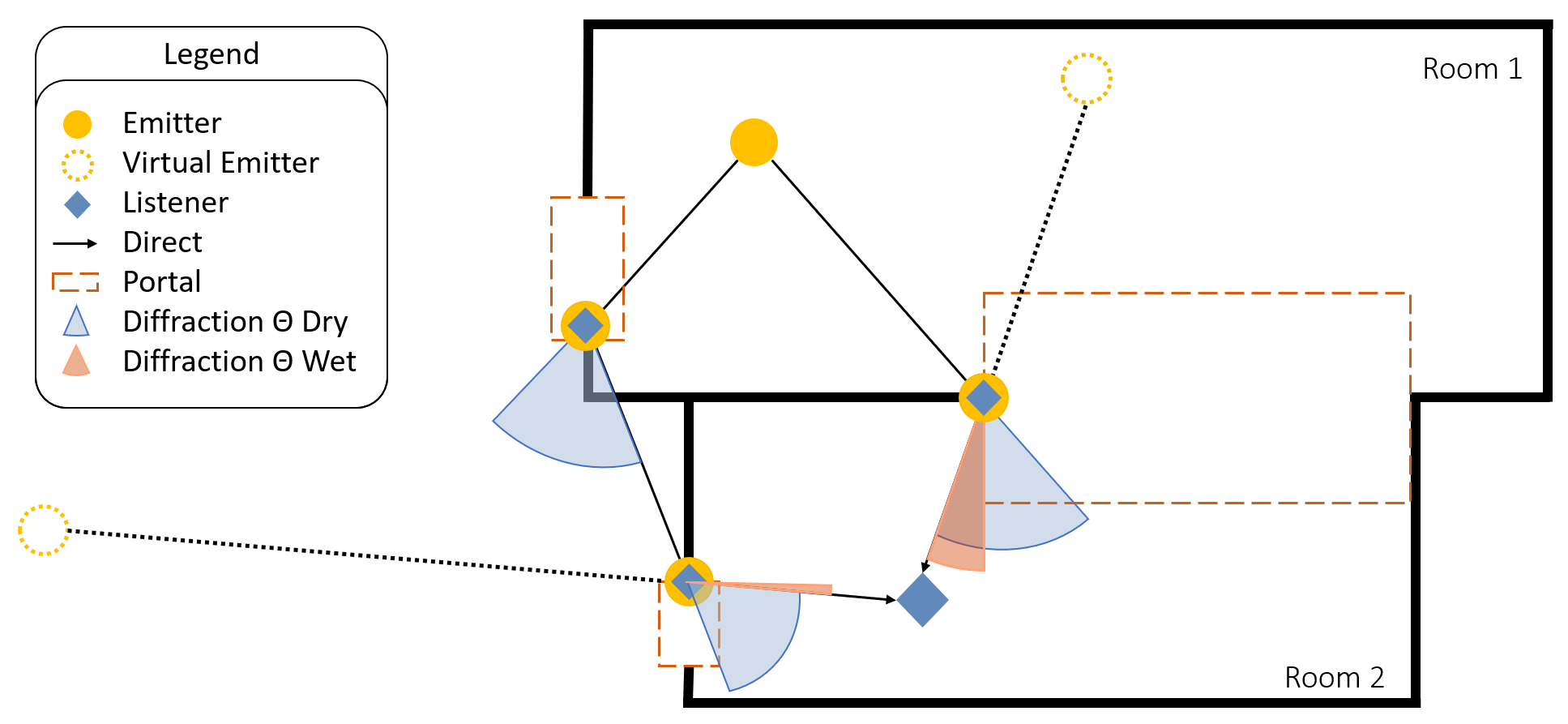Wwise Spatial Audio is a family of built-in spatial audio features complemented by in-house and 3rd party plug-ins that seamlessly integrate with the Wwise production workflow. Wwise Spatial Audio specializes in sound propagation, virtual acoustics, and spatially informed audio rendering. As a continuing research field at Audiokinetic, many new spatial audio features, plug-ins, and partnerships can be expected in the coming years.
Geometry
The Wwise Spatial Audio Geometry API uses emitter and listener positions, and the raw triangles of your game's (typically simplified) geometry in order to compute image sources for simulating dynamic early reflections, in conjunction with the Wwise Reflect plug-in. Sound designers control translation of image source positions into early reflections directly in Wwise Reflect, through tweaking of properties based on distance and materials.
Rooms and Portals
The Wwise Spatial Audio module exposes a simple, high-level geometry abstraction called Rooms and Portals, which allows it to efficiently model sound propagation of emitters located in other rooms. The main features of room-driven sound propagation are diffraction, coupling, and spatialization of reverbs. It does so by leveraging the tools at the disposal of the sound designer in Wwise, leaving them full control of the resulting transformations to audio. Furthermore, it allows you to restrict game engine-driven raycast-based obstruction, which is highly game engine-specific, and typically costly in terms of performance, to emitters that are in the same room as the listener.

Wwise Core
3D busses provide developers with the building blocks for a performant sound propagation solution by submixing groups of sounds and/or reverb anywhere in the signal flow, and positioning these submixes in the 3D world. This makes them a key component in implementing spatial audio effects, such as dynamic room portals and oriented reverb.
Ambisonics is fully supported in the Wwise voice pipeline, which makes it easy to import ambisonic files, submix other channel configurations to the ambisonics format, and ultimately have an ambisonic output that can be played natively on any of an increasing number of platforms supporting ambisonics. A cross platform audio delivery solution, this surround sound format produces a regular spherical representation of the sound field surrounding the listener and is speaker configuration and binaural filter agnostic. Ambisonics in Wwise: Overview.
Acoustic textures, used in combination with the Wwise Reflect plug-in, help reflective surfaces imitate the natural sound of different materials, such as wood, concrete, and drywall. Parameters to define a surface's roughness and the amount of dampening within certain frequencies ensure the right sound can be found for any material.
Wwise Plug-ins
Audiokinetic has developed a series of premium plug-ins that target the specific needs of interactive sound design and enhance the Wwise experience.
Wwise Convolution lets you create convincing reverberation based on samples of real acoustic spaces, from the smallest room to the largest cathedral. You can use the impulse responses provided by Audiokinetic and AudioEase. Or import your own in any channel configuration, including ambisonics.
Wwise Reflect is a geometry-informed plug-in that dynamically renders early reflections based on the proximity of the listener/emitter to reflective surfaces, such as walls, ceilings, and floors. Wwise Reflect not only enhances immersion and the sense of space, but also brings out variety and naturalness from limited audio assets by blending them with a dynamic environment. Wwise Reflect offers full customization, catering to the artistic needs of sound designers and today’s interactive media narrative and storytelling demands.
Integrations
Wwise Spatial Audio integrates easily into in-house game engines and the world's top commercial game engines. The Wwise Unreal plug-in and the Wwise Unity plug-in allow the integration of spatial audio components in a game via features such as Rooms and Portals, 3D positioned Sound SFX, and acoustic textures, alongside the Reflect plug-in via the Wwise Authoring Tool.
Unreal 5
Learn more about using Wwise Spatial Audio in Unreal 5
Unity
Learn more about using Wwise Spatial Audio in Unity
Wwise Audio Lab
Prototype ideas, evaluate different approaches, and polish the results in a controlled virtual environment.
Wwise Audio Lab (WAL) is an open-source game-like 3D environment developed with Unreal Engine 4, which runs on Mac, Windows, Oculus, and HTC Vive. It showcases various spatial audio methods and technologies, such as geometry-informed dynamic early reflections, acoustic portals, oriented reverb, and more. Information nodes distributed in the maps help identify sound propagation phenomena, and in-game options allow for instant A-B comparisons between various spatial audio approaches. Although the WAL is designed for experimenting with spatial audio features, the project is fully customizable for users interested in finding the perfect combination of tools and methods for their future projects.